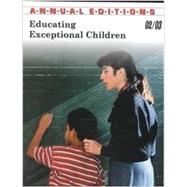| To the Reader | iv | ||||
| Topic Guide | xi | ||||
| Selected World Wide Web Sites | xiv | ||||
| UNIT 1 Inclusive Education | |||||
|
|||||
|
xvi | ||||
|
|||||
|
|||||
|
2 | (6) | |||
|
|||||
|
|||||
|
|||||
|
8 | (8) | |||
|
|||||
|
|||||
|
|||||
|
16 | (4) | |||
|
|||||
|
|||||
|
20 | (6) | |||
| UNIT 2 Early Childhood | |||||
|
|||||
|
26 | (2) | |||
|
|||||
|
|||||
|
|||||
|
|||||
|
28 | (6) | |||
|
|||||
|
|||||
|
34 | (3) | |||
|
|||||
|
|||||
|
|||||
|
37 | (7) | |||
| UNIT 3 Learning Disabilities | |||||
|
|||||
|
44 | (2) | |||
|
|||||
|
|||||
|
46 | (17) | |||
|
|||||
|
|||||
|
63 | (5) | |||
|
|||||
|
|||||
|
|||||
|
68 | (4) | |||
| UNIT 4 Speech and Language Impairments | |||||
|
|||||
|
72 | (2) | |||
|
|||||
|
|||||
|
74 | (3) | |||
|
|||||
|
|||||
|
|||||
|
77 | (5) | |||
|
|||||
|
|||||
|
|||||
|
|||||
|
82 | (5) | |||
| UNIT 5 Developmental Disabilities | |||||
|
|||||
|
87 | (2) | |||
|
|||||
|
|||||
|
|||||
|
|||||
|
|||||
|
89 | (6) | |||
|
|||||
|
|||||
|
|||||
|
|||||
|
|||||
|
|||||
|
95 | (9) | |||
|
|||||
|
|||||
|
|||||
|
104 | (5) | |||
| UNIT 6 Emotional and Behavioral Disorders | |||||
|
|||||
|
109 | (2) | |||
|
|||||
|
|||||
|
|||||
|
111 | (6) | |||
|
|||||
|
|||||
|
|||||
|
|||||
|
|||||
|
|||||
|
|||||
|
|||||
|
|||||
|
117 | (6) | |||
|
|||||
|
|||||
|
|||||
|
|||||
|
|||||
|
123 | (4) | |||
| UNIT 7 Vision and Hearing Impairments | |||||
|
|||||
|
127 | (2) | |||
|
|||||
|
|||||
|
129 | (4) | |||
|
|||||
|
|||||
|
133 | (7) | |||
|
|||||
|
|||||
|
|||||
|
|||||
|
140 | (7) | |||
| UNIT 8 Multiple Disabilities | |||||
|
|||||
|
147 | (2) | |||
|
|||||
|
|||||
|
|||||
|
149 | (6) | |||
|
|||||
|
|||||
|
|||||
|
155 | (7) | |||
|
|||||
|
|||||
|
|||||
|
162 | (9) | |||
| UNIT 9 Orthopedic and Health Impairments | |||||
|
|||||
|
171 | (2) | |||
|
|||||
|
|||||
|
173 | (7) | |||
|
|||||
|
|||||
|
180 | (4) | |||
|
|||||
|
|||||
|
184 | (6) | |||
| UNIT 10 Giftedness | |||||
|
|||||
|
190 | (2) | |||
|
|||||
|
|||||
|
192 | (4) | |||
|
|||||
|
|||||
|
196 | (4) | |||
|
|||||
|
|||||
|
200 | (4) | |||
| UNIT 11 Transition | |||||
|
|||||
|
204 | (2) | |||
|
|||||
|
|||||
|
|||||
|
|||||
|
206 | (6) | |||
|
|||||
|
|||||
|
|||||
|
|||||
|
|||||
|
|||||
|
212 | (7) | |||
| Index | 219 | (3) | |||
| Test Your Knowledge From | 222 | (1) | |||
| Article Rating Form | 223 |









